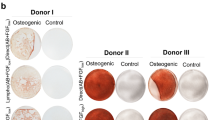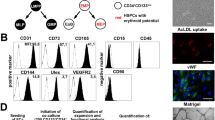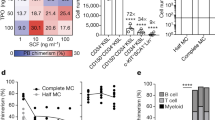Abstract
Intravenous infusion of bone marrow stromal cells (BMSCs) has been proposed as a means to support hematopoiesis in bone marrow transplantation or as a vehicle for gene therapy. However, it seems that this route of injection leads to engraftment of a small proportion of BMSCs, possibly because they are unable to cross the endothelial barrier. We have transplanted human BMSCs, ex vivo expanded and transduced with a retrovirus encoding the human erythropoietin gene, either intravenously or subcutaneously with or without a tridimensional scaffold in non-conditioned NOD/SCID mice. Efficiency of engraftment was evaluated monitoring the hematocrit levels. Systemic infusion never significantly increased hematocrit levels, whereas subcutaneous transplantation of the same number of cells induced an important increase of the hematocrit (approximately 70%) for at least 2 months. A substantial increase in the length of the response was observed when cells were subcutaneously transplanted in a tridimensional scaffold. To determine whether the transient effect was due to cell loss or to reduction in expression, the cells implanted into a tridimensional scaffold were recovered, expanded in vitro, and re-implanted in a new group of mice. Again the hematocrit levels rose 2 weeks after transplantation (≈70%). These results demonstrate that ex vivo expanded human BMSCs are not quantitatively transplantable by systemic infusion in non-conditioned recipients, whereas the local implantation into a tridimensional scaffold allows long-term engraftment and efficient expression of a foreign gene.
This is a preview of subscription content, access via your institution
Access options
Subscribe to this journal
Receive 12 print issues and online access
$259.00 per year
only $21.58 per issue
Buy this article
- Purchase on Springer Link
- Instant access to full article PDF
Prices may be subject to local taxes which are calculated during checkout







Similar content being viewed by others
References
Bianco P, Gehron Robey P . Marrow stromal stem cells J Clin Invest 2000 105: 1663–1668
Bianco P, Riminucci M, Gronthos S, Robey PG . Bone marrow stromal stem cells: nature, biology, and potential applications Stem Cells 2001 19: 180–192
Nilsson SK et al. Cells capable of bone production engraft from whole bone marrow transplants in nonablated mice J Exp Med 1999 189: 729–734
Dao MA, Pepper KA, Nolta JA . Long-term cytokine production from engineered primary human stromal cells influences human hematopoiesis in an in vivo xenograft model Stem Cells 1997 15: 443–454
Koc ON et al. Bone marrow-derived mesenchymal stem cells remain host-derived despite successful hematopoietic engraftment after allogeneic transplantation in patients with lysosomal and peroxisomal storage diseases Exp Hematol 1999 27: 1675–1681
Galotto M et al. Stromal damage as consequence of high-dose chemo/radiotherapy in bone marrow transplant recipients Exp Hematol 1999 27: 1460–1466
Cilloni D et al. Limited engraftment capacity of bone marrow-derived mesenchymal cells following T cell-depleted hematopoietic stem cell transplantation Blood 2000 96: 3637–3643
Allay JA et al. LacZ and interleukin-3 expression in vivo after retroviral transduction of marrow-derived human osteogenic mesenchymal progenitors Hum Gene Ther 1997 8: 1417–1427
Chuah MK et al. Long-term persistence of human bone marrow stromal cells transduced with factor VIII-retroviral vectors and transient production of therapeutic levels of human factor VIII in nonmyeloablated immunodeficient mice Hum Gene Ther 2000 11: 729–738
Rao SS et al. Stem cell transplantation in the normal nonmyeloablated host: relationship between cell dose, schedule, and engraftment Exp Hematol 1997 25: 114–121
Stewart FM et al. Lymphohematopoietic engraftment in minimally myeloablated hosts Blood 1998 91: 3681–3687
Osborne WR et al. Gene therapy for long-term expression of erythropoietin in rats Proc Natl Acad Sci USA 1995 92: 8055–8058
Bartholomew A et al. Baboon mesenchymal stem cells can be genetically modified to secrete human erythropoietin in vivo Hum Gene Ther 2001 12: 1527–1541
Muraglia A, Cancedda R, Quarto R . Clonal mesenchymal progenitors from human bone marrow differentiate in vitro according to a hierarchical model J Cell Sci 2000 113: 1161–1166
Markowitz D, Goff S, Bank A . A safe packaging line for gene transfer: separating viral genes on two different plasmids J Virol 1988 62: 1120–1124
Markowitz D, Goff S, Bank A . Construction and use of a safe and efficient amphotropic packaging cell line Virology 1988 167: 400–406
Cone RD, Mulligan RC . High-efficiency gene transfer into mammalian cells: generation of helper-free recombinant retrovirus with broad mammalian host range Proc Natl Acad Sci USA 1984 81: 6349–6353
Johnstone B et al. In vitro chondrogenesis of bone marrow-derived mesenchymal progenitor cells Exp Cell Res 1998 238: 265–272
Muraglia A, Martin I, Cancedda R, Quarto R . A nude mouse model for human bone formation in unloaded conditions Bone 1998 22: 131S–134S
Acknowledgements
This work was supported by grants from AIRC (Associazione Italiana Ricerca sul Cancro), MIUR and Ministero della Sanita’ to GC and RC.
Author information
Authors and Affiliations
Rights and permissions
About this article
Cite this article
Daga, A., Muraglia, A., Quarto, R. et al. Enhanced engraftment of EPO-transduced human bone marrow stromal cells transplanted in a 3D matrix in non-conditioned NOD/SCID mice. Gene Ther 9, 915–921 (2002). https://doi.org/10.1038/sj.gt.3301727
Received:
Accepted:
Published:
Issue Date:
DOI: https://doi.org/10.1038/sj.gt.3301727
Keywords
This article is cited by
-
Revisiting the role of erythropoietin for treatment of ocular disorders
Eye (2016)
-
Nonviral gene delivery of erythropoietin by mesenchymal stromal cells
Gene Therapy (2012)
-
Erythropoietin Gene-enhanced Marrow Mesenchymal Stromal Cells Decrease Cisplatin-induced Kidney Injury and Improve Survival of Allogeneic Mice
Molecular Therapy (2011)



